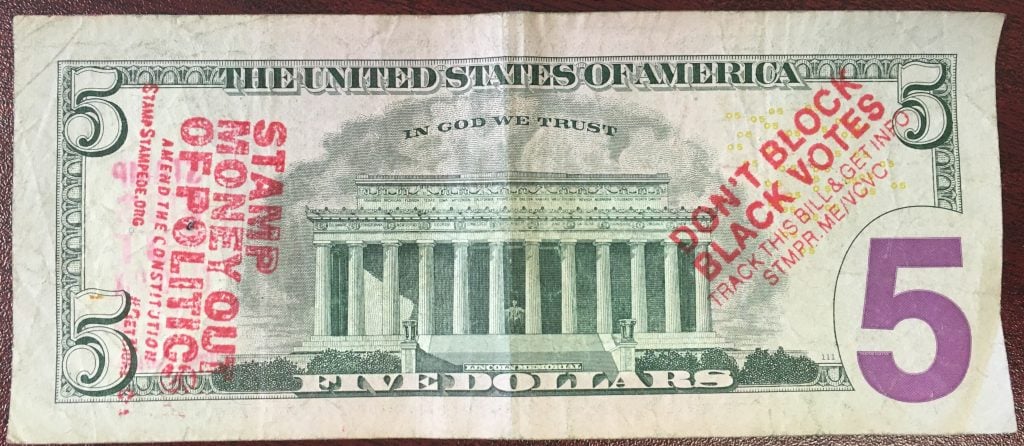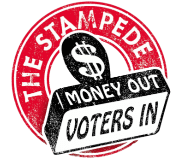Types of Stamps
 Wooden handled stamps are easy to position on the bill and provide an excellent stamped image due to their spongy rubber backing that takes the dye from the quality Palette brand ink pad. Not to mention that same ink is also WATERPROOF. These stamps are also more tolerant of stamping money on uneven surfaces. In addition, the ergonometric design of the iconic wooden handle is very comfortable and satisfying to use, and good looking in a retro kind of way. They are also the least expensive stamps we sell. Wooden handled stamps are the comfort food of the stamping world. They are simple, with no moving parts; these are the workhorses of the bunch. And they don’t take any significant amount of extra time if you are going to sit down and stamp a bunch of bills. This is Head Stamper Ben’s new stamp of choice for serious stamping sessions.
Wooden handled stamps are easy to position on the bill and provide an excellent stamped image due to their spongy rubber backing that takes the dye from the quality Palette brand ink pad. Not to mention that same ink is also WATERPROOF. These stamps are also more tolerant of stamping money on uneven surfaces. In addition, the ergonometric design of the iconic wooden handle is very comfortable and satisfying to use, and good looking in a retro kind of way. They are also the least expensive stamps we sell. Wooden handled stamps are the comfort food of the stamping world. They are simple, with no moving parts; these are the workhorses of the bunch. And they don’t take any significant amount of extra time if you are going to sit down and stamp a bunch of bills. This is Head Stamper Ben’s new stamp of choice for serious stamping sessions.
The MaxLight pre-inked pocket stamps use self-contained, WATERPROOF, oil-based ink. It is long-lasting, HOWEVER, it will “feather.” That means that the stamped image on the bill will spread over the first 72 hours. With a little practice, you can learn to stamp lightly so that the image is legible but not overly inked. Be sure to check after 72 hours until you get the hang of it. The best part about this stamp is that it is small and portable and self-contained. It can be re-inked, but you must use oil-based ink.
All of the other self-inking stamps use water-based ink. They are self-contained and don’t require a separate ink pad. The stamped image from these stamps will not feather, but they are not waterproof. There are two types of these stamps, and both of them stamp the same image size:
Self-inking desk stamps—These stamps use a larger case. Rugged and reinkable, they are designed to be used on a desk or table. However, because reinking can get a bit messy, we recommend you go with a replacement pad, which you can find here. They are a little more difficult to position on the bill because their casing is on the bigger side.
Self-inking spring out pocket stamps—The case on these stamps are so small, they easily fit in your pocket. They have a very cool spring-like action when you open it, much like a switchblade–so you can really impress your friends with it. Since the full dimension of the dye is visible and exposed on these stamps, they are very easy to position on the bill. You can also get a replacement ink pad for this pocket stamp when your ink runs out. But there are two downsides to these stamps: (1) They are not as durable. It helps to press down on the dye with two additional fingers once you press it to a bill; (2) They require you to manually slide the stamp and close it in order to re-ink the dye after each bill you stamp.
STAMPING MONEY IS AN ART
The goal is to stamp your money so that your message is legible, prominent, motivates sighting reports, AND so that it does not get taken out of circulation by the banking system which uses automated scanners to remove “soiled currency” from circulation.
In order to keep your work of art in circulation it’s best to avoid stamping over the “security features” on the dollar:
- The two round seals on the front
- The serial number
- Any metallic ink on higher denomination bills
It’s also good form to avoid stamping over the face of a dead president.
It helps to stamp on both the front and back of the bill.
Getting big money out of politics and ending voter suppression are two sides of the same coin—without these changes, we keep the power in the hands of the wealthy and privileged. So we encourage stamping one side of the bill with a get-money-out-of-politics stamp (for example “NOT TO BE USED TO BUY ELECTIONS”) and the other side with an end-voter-suppression stamp.

For stamps that require a separate ink pad, the Palette brand, which is sold on our site is recommended. It’s waterproof, long lasting and the ink does not “feather” (spread and blur) on paper currency.
STAMPING IS LEGAL on all denominations. But lower denominations, particularly $1s and $5s, circulate into other people’s hands more rapidly so you can get a quicker bang for your buck with them. Additionally, the lower denominations tend to stay more local.
ROCKING AND ROLLING
Contrary to popular conception, it’s not about slamming the stamp down on the bill. It’s about gently placing the stamp on the bill, pushing down, and moving the pressure side to side AND back and forth.
You will find that with the self-inking or pre-inked stamps, it’s best to stamp off the excess ink at the beginning of a stamping session on a piece of scrap paper. If you stamp lots of bills in a row, you will need to press down longer and harder as your stamping session continues.
